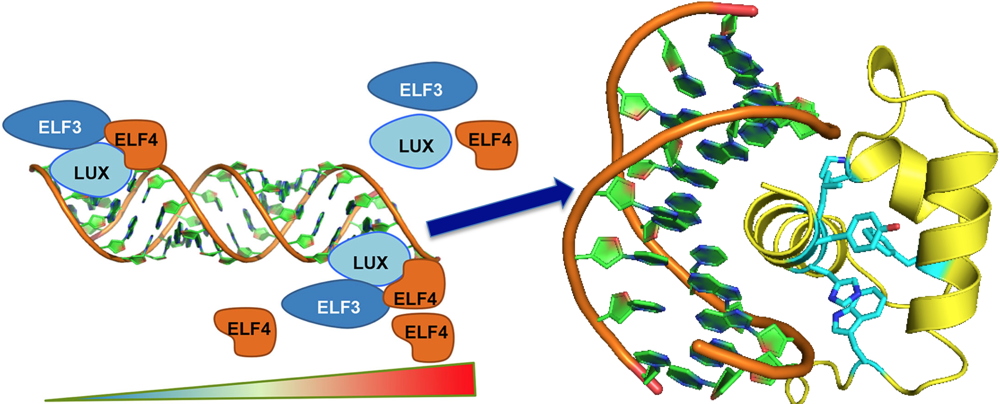Seeing trees blooming in the middle of winter is not unusual anymore. Plants are very sensitive to their environment and can sense changes in temperature of just a few degrees. These slight elevations in temperature due to global warming cause some of them to flower earlier and earlier in the season. This can lead to many negative effects in wild and crop plants including reduced seed production, smaller and fewer fruits and decreased biomass. For these reasons, it is fundamental to understand how plants perceive and respond to temperature as the
phenology of plants, their seasonal growth and development, change with the changing environment.
The Evening Complex (EC) is a protein complex that acts as a repressor of gene expression. It is essential to the plant's circadian clock and helps regulate the growth of the plant in a temperature-sensitive manner in a number of different species. The EC is made of three proteins, LUX ARRHYTMO (LUX), EARLY FLOWERING 3 (ELF3) and EARLY FLOWERING 4 (ELF4). In this study, we examined the role of these three proteins
in vitro and their DNA binding activity with respect to temperature. We showed that LUX binds to DNA (
Figure) with high specificity and recruits ELF3 and ELF4 to the DNA. Ultimately, only the activity of ELF3 is directly dependent on temperature: when the temperature rises, ELF3 prevents the complex from binding to the DNA; it then becomes less active and can no longer repress growth and flowering.
Based on the crystal structure of LUX, a mutation was designed that decreased EC binding to DNA. This mutation was introduced into the model plant Arabidopsis. As a result, plants grew faster and flowered earlier, even at lower temperatures. These data indicate that changes in the DNA-binding affinity of LUX can have an effect on the entire complex and result in plants that have changed sensitivity to warmer temperatures with respect to their growth and flowering time.
Understanding the molecular mechanisms underlying EC activity, in particular how different protein partners contribute to its DNA-binding activity, helps explain how small changes in temperature lead to profound changes in plant growth.

The Evening Complex (EC) acts as a thermosensor by binding DNA at low temperatures and repressing its target genes. But when the temperature rises, the complex dissociates from the DNA and gene expression occurs, resulting in early flowering. The structure of the EC protein, LUX ARRYTHMO, linked to the DNA is shown above: on the left, EC is presented around the DNA. On the right the structure of the LUX protein is shown attached to the DNA double helix.
In plants, phenology is the study of their seasonal development phases: foliage, flowering, fruiting, autumn yellowing. These developments are linked to certain climatic parameters.